Philip I Crowned King of France
Richard Cavendish looks back at the Capetian monarch, crowned aged seven, on 23 May 1059.

The name Philip was Greek and uncommon in the Western Europe of the 11th century. Meaning ‘lover of horses’ (philippos), it was probably bestowed on the future Capetian monarch by his mother, Anne, a princess of Kiev. According to contemporaries, ‘lover of women’ would have been more appropriate, and he grew far too fat to ride a horse. He was only seven when his father Henry I had him crowned at Rheims as co-king. Henry died the following year and until he came of age at 14 in 1066, Philip’s mother and Count Baldwin V of Flanders acted as his regents. He grew up to be an efficiently unscrupulous king who made the best of the monarchy’s weak position. He enlarged the royal domains and contrived to play off succeeded the Conqueror in 1087.





